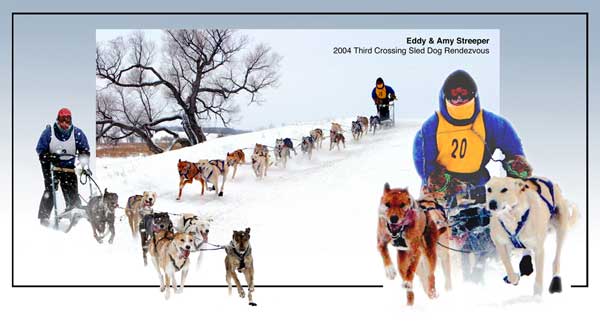

Alaska's History in Brief
Russian Colonization
The disastrous voyage of Vitus Bering and Aleksey Chirikov in 1741 began the march of Russian traders across Siberia. The survivors who returned with sea otter skins started a rush of fur hunters to the Aleutian Islands. Grigori Shelekhov in 1784 founded the first permanent settlement in Alaska on Kodiak Island and sent (1790) to Alaska the man who was to dominate the period of Russian influence there, Aleksandr Baranov. A monopoly was granted to the Russian American Company in 1799, and it was Baranov who directed its Alaskan activities.
The Russian Orthodox Church and Native Alaskans
The primary goal of the Alaska mission was to convert the Native population to Orthodox Christianity. Conversion was encouraged by the Tsar, as head of the Church, and by the hierarchy. Rules for converting Natives strictly forbade using coercion. Orthodox missionaries were generally successful in their conversions, more so among the Aleuts and Eskimos than the Tlingits. Among the obstacles to conversion were the language barrier, and the shamanistic traditions of the Natives, deeply entrenched in the culture.
Today, Alaskans are proud of their Russian heritage and active Orthodox Churches are to be found in many towns. |

Early Years as a U.S. PossessionIn 1867, Russia sold Alaska to the United States for $7,200,000. The U.S. purchase was accomplished solely through the determined efforts of Secretary of State William H. Seward, and for many years afterward the land was derisively called Seward's Folly or Seward's Icebox because of its supposed uselessness. Since Alaska appeared to offer no immediate financial return, it was neglected. The U.S. army officially controlled the area until 1876, when scandals caused the withdrawal of the troops. After a brief period, during which government was in the hands of customs officials, the U.S. navy was given charge (1879). It was not until after the discovery of gold in the Juneau region in 1880 that Alaska was given a governor and a feeble local administration.
The Gold Rush
The Klondike strike of 1896 brought a stampede, mainly of Americans, and most of them came through Alaska. The big discoveries in Alaska itself followed—Nome in 1898–99, Fairbanks in 1902. The miners and prospectors (the sourdoughs) took over Alaska. |
"North to Alaska,
They're goin' North,
the rush is on!"

The steamship Portland had just pulled into Seattle, returning from the Yukon with over a ton of gold. Her arrival instantly sparked an all-out human stampede for the Yukon.
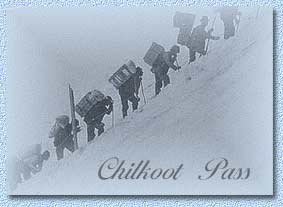 To seek their fortunes in the Yukon gold fields, prospectors had to make their way along the Inside Passage, cross the Chilkoot Mountains with a ton of supplies, build a raft or boat during the long, hard winter, and then float 550 miles down the Yukon River to Dawson. After reaching Dawson, each prospector had to stake a claim and spend countless weeks, months, or years digging his claim before panning or sluicing the dirt, hoping to strike it rich, but more likely scratching out a meager existence. To seek their fortunes in the Yukon gold fields, prospectors had to make their way along the Inside Passage, cross the Chilkoot Mountains with a ton of supplies, build a raft or boat during the long, hard winter, and then float 550 miles down the Yukon River to Dawson. After reaching Dawson, each prospector had to stake a claim and spend countless weeks, months, or years digging his claim before panning or sluicing the dirt, hoping to strike it rich, but more likely scratching out a meager existence.
While the gold fields lay far to the north, towns like Skagway and Dyea became boomtowns almost overnight. These towns marked the start of the overland portion of the Trail of ‘98 – Alaska’s gateway to the Klondike. With numerous saloons, brothels, and a full complement of gunslingers, con men, drunkards, and outlaws, Skagway was a feral, lawless Wild West of the north.
Most of the would-be prospectors came to Alaska with little or no knowledge of mining or backcountry survival. Many soon found themselves questing no longer merely for fortune, but for their very survival. Not surprisingly, of the 100,000 who set out, only a few thousand ever reached the gold fields – and only a mere handful ever struck it rich.
~ A Historical Vignette ~
Jefferson Randolph “Soapy” Smith was a Western crook with the gift of organization. A southern charmer and a master of the bait and switch, he was a confidence man who dressed like a judge, sat on a horse like a prince, and spoke like a bishop. He honed his skills in Texas and Colorado. Gradually he gathered shills and toughs around him, and commanded his gang of “lambs” as a colonel might command a battalion. When the Klondike Gold Rush began in 1897, he knew that the tenderfeet headed for northern goldfields would be ripe for the picking, and chose raw, lawless Skagway as his headquarters. In this bleak settlement at the head of Alaska’s Lynn Canal, he constructed an empire that any Mafia don might envy. However, less than a year later, the town had had enough of Soapy. He was killed by Frank Reid, in 1898 when he was 38 years old. Soapy's life story is a rip-snorting portrait of the rise to power of a man without a conscience. It reveals the strong-arm robberies, bloody trail murders, illegitimate businesses, rigged card games, and garish, candle-lit honky-tonks of the Gold Rush.

One of Soapy's best cons involved his "telegraph office." Recent arrivals were greeted by men who offered to send telegrams to their families for only $5. Most people did not look behind the "telegraph office" to notice that the wires ended a few yards out.
Territorial StatusJuneau officially replaced Sitka as capital in 1900, but it did not begin to function as such until 1906. In the same year Alaska was finally awarded a territorial representative in Congress. A new era began for Alaska when local government was established in 1912 and it became a U.S. territory.
Statehood
In 1958, Alaskans approved statehood by a 5 to 1 vote, and on Jan. 3, 1959, Alaska was officially admitted into the Union as a state, the first since Arizona in 1912. |
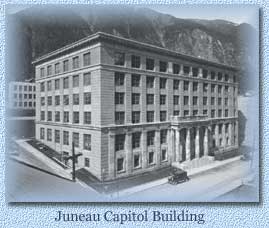
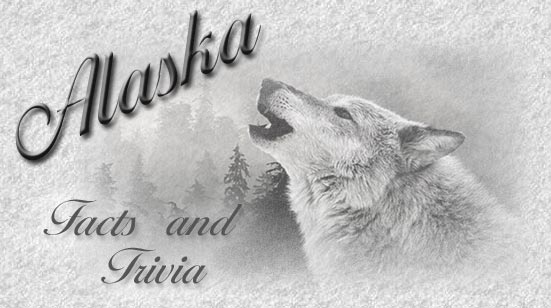
- Outsiders first discovered Alaska in 1741 when Danish explorer Vitus Jonassen Bering sighted it on a voyage from Siberia.
- In 1867 United States Secretary of State William H. Seward offered Russia $7,200,000, or two cents per acre, for Alaska.
- On October 18, 1867 Alaska officially became the property of the United States. Many Americans called the purchase "Seward's Folly."
- Joe Juneau's 1880 discovery of gold ushered in the gold rush era.
- In 1943 Japan invaded the Aleutian Islands, which started the One Thousand Mile War, the first battle fought on American soil since the Civil War.
- Alaska officially became the 49th state on January 3, 1959.
- Alaska's most important revenue source is the oil and natural gas industry.
- The state of Rhode Island could fit into Alaska 425 times.
- Prudhoe Bay, on the northern Alaskan coast, is North America's largest oil field.
- The Trans-Alaska Pipeline moves up to 88,000 barrels of oil per hour on its 800 mile journey to Valdez.
- Most of America's salmon, crab, halibut, and herring come from Alaska.
- The term Alaska native refers to Alaska's original inhabitants including Aleut, Eskimo and Indian groups.
- Dog mushing is the official state sport. The Alaska Legislature adopted it in 1972.
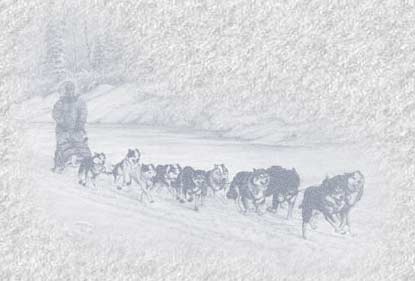
Click here to read about
"The Last Great Race on Earth", the Iditarod!
- The state motto is North to the Future.
- Gold is the official state mineral. It was named the state mineral in 1968.
- Alaska has been called America's Last Frontier.
- Every four years Alaskans elect a Governor and a Lieutenant Governor to four-year terms.
- The Alaska State Legislature is made up of a Senate and a House of Representatives.
- Twenty senators are elected to four-year terms; forty representatives serve two-year terms.
- Alaska's Constitution was adopted in 1956 and became effective in 1959 making it the 49th state.
- Nearly one-third of Alaska lies within the Arctic Circle.
- The Alaska Highway was originally built as a military supply road during World War II.
- The state boasts the lowest population density in the nation.
- The discovery of gold in the Yukon began a gold rush in 1898. Later gold was discovered at Nome and Fairbanks.
- Alaska is a geographical marvel. When a scale map of Alaska is superimposed on a map of the 48 lower states, Alaska extends from coast to coast.
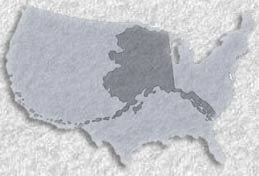
- The state's coastline extends over 6,600 miles.
- Alaska is the United State's largest state and is over twice the size of Texas. Measuring from north to south the state is approximately 1,400 miles long and measuring from east to west it is 2,700 miles wide.
- Alaska's geographic center is 60 miles northwest of Mount McKinley.
- The Tongass National Forest is the largest national forest in the United States.
- 17 of the 20 highest peaks in the United States are located in Alaska.
- At 20,320 feet above sea level, Mt. McKinley, located in Alaska's interior, is the highest point in North America.
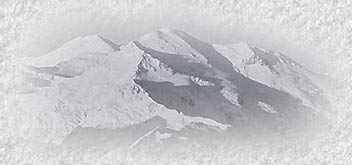
- Juneau is the only capital city in the United States accessible only by boat or plane.
- The state's largest city is Anchorage; the second largest is Fairbanks.
- The Alaska Range is the largest mountain chain in the state. It covers from the Alaska Peninsula to the Yukon Territory.
- In 1915 the record high temperature in Alaska was 100 degrees Fahrenheit at Fort Yukon; the record low temperature was -80 degrees Fahrenheit at Prospect Creek Camp in 1971.
- The Alaskan malamute sled dog is strong and heavily coated. It was developed as a breed by a group of Eskimos named the Malemiuts.

- Alaska's name is based on the Eskimo word Alakshak meaning great lands or peninsula.
- Agattu, Attu, and Kiska are the only parts of North America occupied by Japanese troops during World War II.
- Oil is the state's most valuable natural resource. The area includes what is thought to be the largest oil field in North America.
- In 1986 Mount Augustine erupted near Anchorage.

The "30-30-30" Rule
Polar and Alaskan explorers cite the "30-30-30" rule,
which states that at -30°F, with winds of 30 MPH,
human flesh will freeze solid in 30 seconds!
|
|


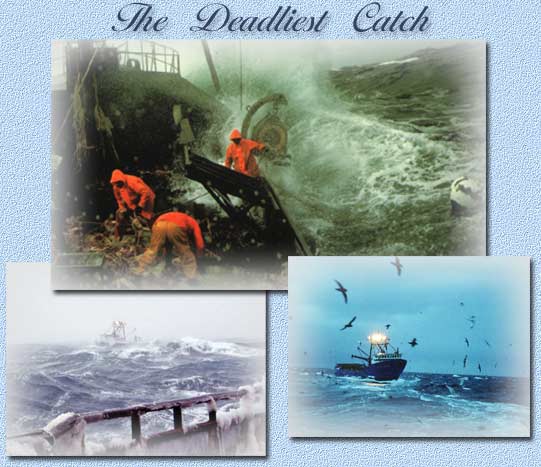
Alaska king crab fishing is considered to be one of the most dangerous jobs in North America. Every year, hundreds of fearless crab fishermen endure extreme weather conditions and harsh work environments with assertive hopes of catching excessive amounts of the most desirable seafood in the world- King crab!
Deep in the frigid waters of the Bering Sea lurks the highly lucrative — and yet often elusive — king crab. Each year, approximately 250 boats converge on Dutch Harbor, Alaska, awaiting the official harvesting season. It could be four days in length or as many as 12 — the fishermen won't know until the voice of the Alaska Department of Fish and Game crackles across their radios to announce the beginning and end of the fishing season.
Forty-foot waves, freezing temperatures, swinging 700-pound crab pots, a nearly 100 percent injury rate ... but also the chance to earn enough money for a family to live on for a year or more, for just a few days' work. Welcome to one of the world's deadliest jobs — that of the Alaskan crab fisherman.
So, the next time you order Alaskan King Crab at your favorite restaurant, remember the men who risked life and limb to bring this wonderful (and expensive) delicacy to your table. :-)
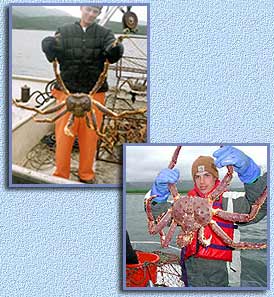
Read more HERE about "The Deadliest Catch".

The following websites provided information
and graphics for this presentation...
Scoundrels Gallery
Wild Things Photography
The Russian Church and Native Alaskan Cultures
The 49th State


|
|
|
|
|
|
|


